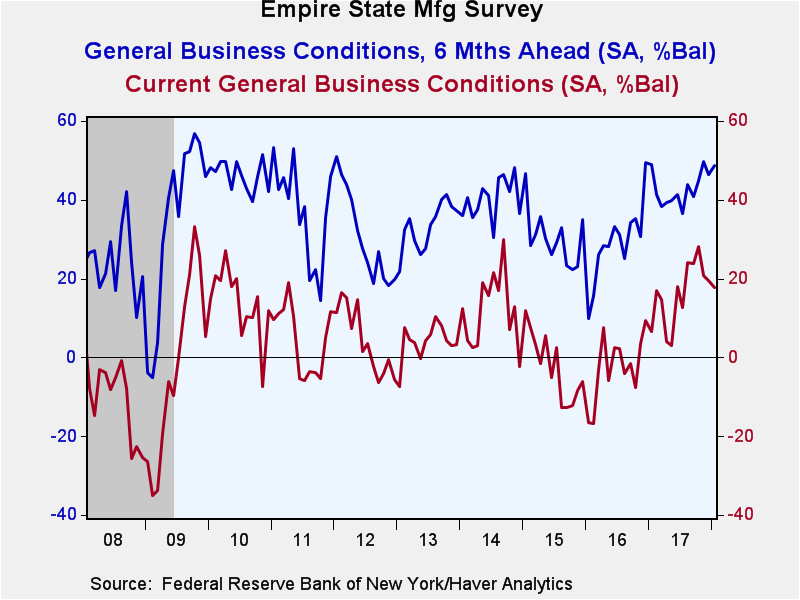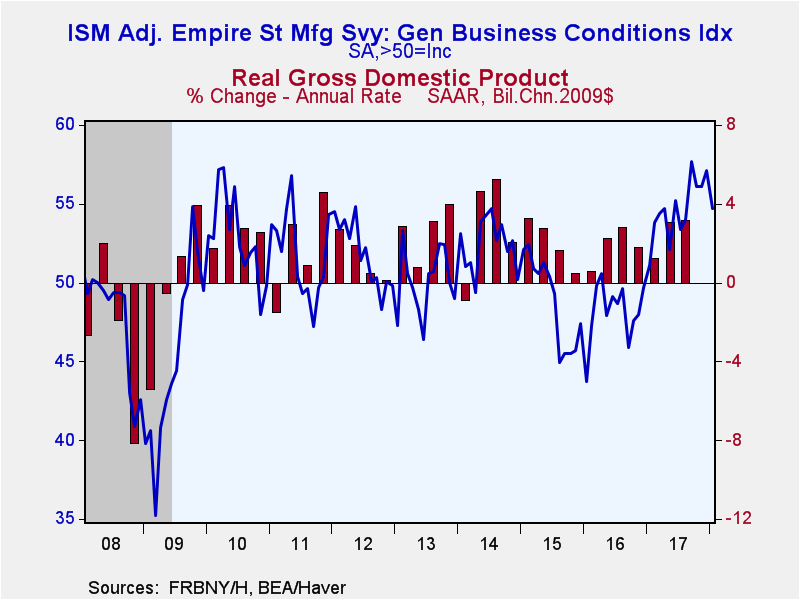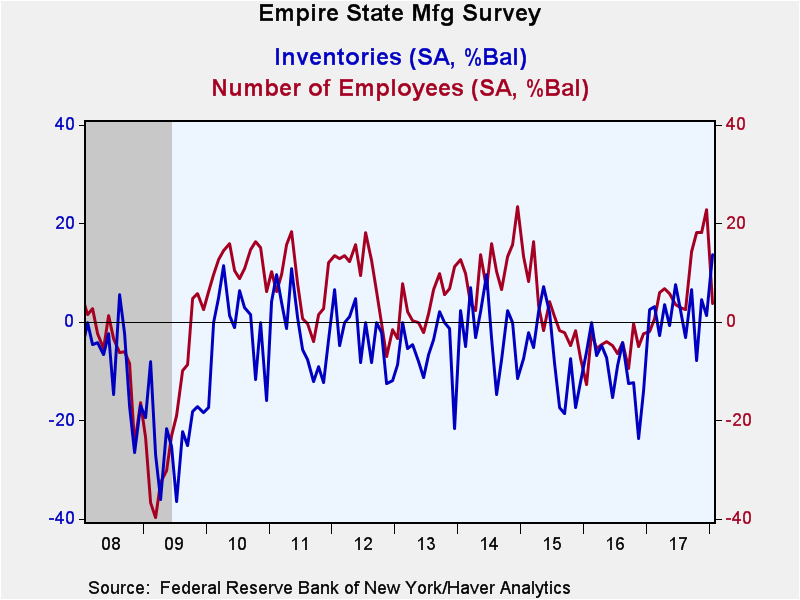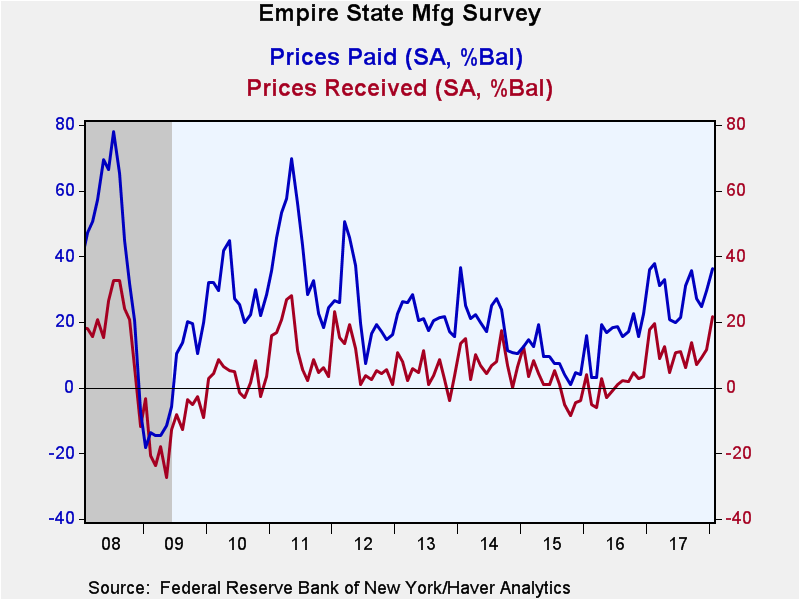 Global| Jan 16 2018
Global| Jan 16 2018Empire State Factory Sector Index Weakens
by:Tom Moeller
|in:Economy in Brief
Summary
The Empire State Manufacturing Index of General Business Conditions in January declined to 17.7 following a revised drop to 19.6 during December. Earlier figures also were revised. The latest level was the lowest in six months, but [...]
The Empire State Manufacturing Index of General Business Conditions in January declined to 17.7 following a revised drop to 19.6 during December. Earlier figures also were revised. The latest level was the lowest in six months, but continued to indicate expansion in factory sector activity. It compared to expectations for 19.0 in the Action Economics Forecast Survey. These data, reported by the Federal Reserve Bank of New York, reflect business conditions in New York, northern New Jersey and southern Connecticut.
Based on these figures, Haver Analytics calculates a seasonally adjusted index that is comparable to the ISM series. The adjusted figure declined to 54.7, the lowest level since August. During the last ten years, the index posted a 67% correlation with the change in real GDP.
The component series exhibited mixed performance m/m. The new orders and shipments series declined to the lowest levels since May, while the delivery times series also fell. The unfilled orders increased. The inventories index surged to the highest level since 1991. A firmer 24% of respondents indicated an increase in inventories while a greatly reduced 10% reported decumulation.
The employment index declined sharply m/m to the lowest level since August. During the last ten years, there has been a 77% correlation between the employment index and the m/m change in factory sector payrolls. Sixteen percent of respondents reported a higher payroll level while twelve percent reported a decline. The employee workweek reading fell sharply to the lowest level in six months.
The prices paid series strengthened to the highest level since February and was up sharply versus the 2015 low. Forty percent of respondents indicated paying higher prices, while four percent reported them lower. The prices received index surged to the highest level in six years.
Expectations of business conditions six months ahead remained fairly stable. The unfilled orders, inventories and delivery times indexes surged while employment and prices paid also advanced.
The Empire State figures are diffusion indexes, which are calculated by subtracting the percent of respondents reporting declines from those reporting gains. The data are available in Haver's SURVEYS database. The ISM-adjusted headline index dates back to 2001. The Action Economics Forecasts can be found in Haver's AS1REPNA database.
What about Spending on Consumer Goods? from the Federal Reserve Bank of New York is available here.
| Empire State Manufacturing Survey | Jan | Dec | Nov | Jan'17 | 2017 | 2016 | 2015 |
|---|---|---|---|---|---|---|---|
| General Business Conditions (Diffusion Index, %, SA) | 17.7 | 19.6 | 20.9 | 6.7 | 16.1 | -2.5 | -2.3 |
| General Business Conditions Index (ISM Adjusted, >50=Increasing Activity, SA) | 54.7 | 57.1 | 56.1 | 51.1 | 54.6 | 48.2 | 48.8 |
| New Orders | 11.9 | 19.0 | 21.3 | 3.6 | 14.6 | -0.7 | -5.6 |
| Shipments | 14.4 | 23.5 | 19.2 | 9.0 | 15.9 | 1.8 | 4.0 |
| Unfilled Orders | 4.3 | -8.7 | -4.6 | -1.7 | 1.9 | -8.8 | -10.5 |
| Delivery Time | 3.6 | 4.3 | -2.3 | -2.5 | 6.1 | -4.8 | -5.3 |
| Inventories | 13.8 | 1.4 | 4.6 | 2.5 | 1.5 | -9.6 | -7.1 |
| Number of Employees | 3.8 | 22.9 | 18.2 | -1.9 | 8.3 | -5.1 | 2.3 |
| Average Employee Workweek | 0.8 | 9.3 | 8.5 | -3.6 | 4.9 | -5.2 | -4.8 |
| Prices Paid | 36.2 | 29.7 | 24.6 | 36.1 | 29.0 | 15.7 | 8.8 |
| Expectations 6 Months Ahead | 48.6 | 46.3 | 49.8 | 49.0 | 42.6 | 29.0 | 30.3 |
Tom Moeller
AuthorMore in Author Profile »Prior to joining Haver Analytics in 2000, Mr. Moeller worked as the Economist at Chancellor Capital Management from 1985 to 1999. There, he developed comprehensive economic forecasts and interpreted economic data for equity and fixed income portfolio managers. Also at Chancellor, Mr. Moeller worked as an equity analyst and was responsible for researching and rating companies in the economically sensitive automobile and housing industries for investment in Chancellor’s equity portfolio. Prior to joining Chancellor, Mr. Moeller was an Economist at Citibank from 1979 to 1984. He also analyzed pricing behavior in the metals industry for the Council on Wage and Price Stability in Washington, D.C. In 1999, Mr. Moeller received the award for most accurate forecast from the Forecasters' Club of New York. From 1990 to 1992 he was President of the New York Association for Business Economists. Mr. Moeller earned an M.B.A. in Finance from Fordham University, where he graduated in 1987. He holds a Bachelor of Arts in Economics from George Washington University.










